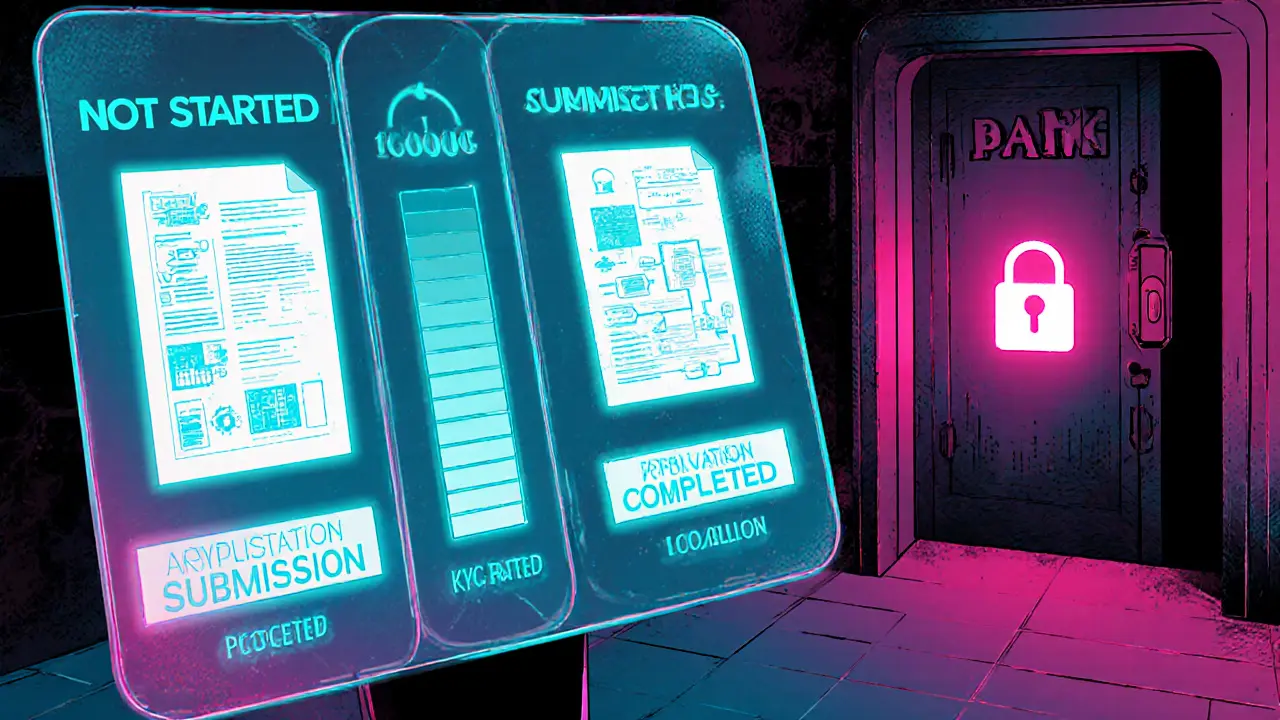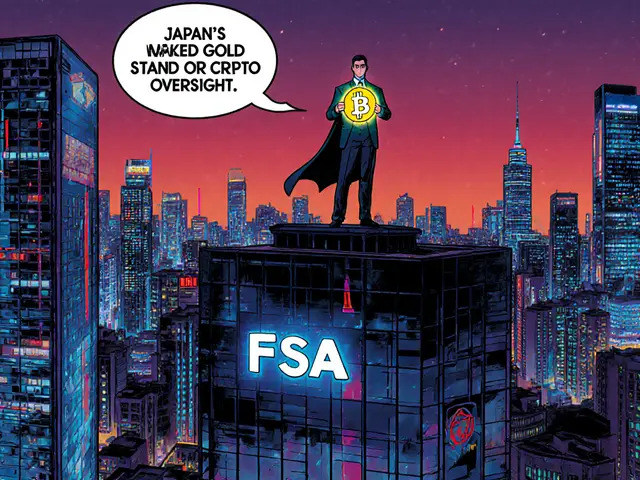Indonesian Crypto Exchange Licensing Requirements Explained
Indonesian Crypto Exchange Licensing Checklist
Under the new DFA framework, crypto exchanges must meet strict capital and compliance requirements to operate legally in Indonesia.
Upload your complete dossier to OJK’s online portal including:
- Technical security blueprint
- Cryptographic protocols
- Key management procedures
- KYC/AML workflows
- Proof of capital deposit
Your Progress Summary
Fill out the fields above to check your progress towards completing the application submission phase.
Ensure your platform meets these key compliance standards:
- Risk-based KYC onboarding
- Real-time transaction monitoring
- Suspicious activity reporting (SAR)
- Auditable logs retention
- Security schema with cold-wallet storage
Indonesian crypto exchange licensing refers to the set of regulatory steps, capital thresholds, and compliance obligations that a digital asset trading platform must meet to operate legally in Indonesia. Since the overhaul on January102025, the process has become more structured but also more demanding. If you’re thinking of launching a platform or expanding an existing service into the archipelago, you need to grasp the new framework, the paperwork marathon, and the ongoing obligations that keep your license alive.
Regulatory Shift: From BAPPEBTI to OJK
Before 2025, the Commodity Futures Trading Authority (BAPPEBTI) was the go‑to regulator for crypto activities. On January102025, the Financial Services Authority (Otoritas Jasa Keuangan OJK) took over, introducing the Digital Financial Assets (DFA) framework under POJK 27/2024. This shift turned crypto exchanges into “Digital Financial Asset Trading Providers” (DFA Traders) while reserving the term “exchange” for entities that manage the broader asset‑listing ecosystem.
The DFA framework aims to position Indonesia as a Southeast Asian crypto hub, but it also brings stricter oversight for consumer protection and market stability. Existing BAPPEBTI licences were grandfathered for a short grace period, yet every operator had to reapply by July2025 to align fully with OJK’s new rules.
Licensing Structure & Capital Requirements
Under POJK 27/2024, the licensing classification is clear:
- DFA Trading Provider: The entity that actually matches buyers and sellers on a platform.
- DFA Exchange: The authority that curates the list of tradable digital assets.
The financial bar remains high. Applicants must demonstrate:
- Paid‑up capital of at least 100billion rupiah (≈US$6million).
- Minimum equity of 50billion rupiah (≈US$3million).
These figures echo the old BAPPEBTI thresholds and act as a deterrent against poorly‑capitalized entrants. The capital must be locked in a local bank account and verified by an OJK‑approved auditor.
Step‑by‑Step Licensing Process
Getting the green light from OJK involves five distinct stages. Skipping any step typically results in a delayed or rejected application.
- Company Registration: Set up a PTPMA (foreign‑owned limited liability company) through the Ministry of Investments portal. The registration must include a clear equity structure and a designated local director.
- Document Collection: Gather corporate statutes, beneficial‑owner disclosures, governance policies, and a detailed business plan. All documents must be translated into Bahasa Indonesia and notarized.
- Application Submission: Upload the complete dossier to OJK’s online licensing portal. This includes a technical security blueprint (cryptographic protocols, key‑management, KYC/AML workflows) and proof of the capital deposit.
- Regulatory Inspection: OJK auditors visit the premises, assess the IT infrastructure, and interview senior compliance officers. They also verify that the AML/KYC systems can generate real‑time transaction alerts.
- License Issuance: After a thorough review-usually 3‑4months-OJK issues the DFA Trading Provider licence, valid for three years pending annual compliance reports.
Failure to meet any documentation or technical standard can trigger a request for clarification (RQC) and extend the timeline by several weeks.
Asset Listing Authority: The DFA Exchange
The newly formed DFA Exchange now decides which crypto assets can be traded on licensed platforms. Its first list, released in April2025, featured 1,444 assets, a 70% jump from BAPPEBTI’s final 851‑asset roster. The exchange reviews the list quarterly, and DFA Traders can submit proposals for new tokens.
Despite this liberal stance, OJK retains the power to ban specific assets or even order a platform to cease trading a particular coin if it poses systemic risk or violates local law.

Compliance Obligations: AML, KYC, and Reporting
All DFA Trading Providers must obey SEOJK No.20 of2024, which codifies anti‑money‑laundering (AML) and know‑your‑customer (KYC) duties. Key requirements include:
- Implement a risk‑based KYC onboarding flow that captures identity documents, source‑of‑funds statements, and politically exposed person (PEP) status.
- Deploy real‑time transaction monitoring that flags suspicious patterns (e.g., rapid large‑volume transfers, use of mixers).
- Submit suspicious activity reports (SARs) to the Financial Transaction Reports and Analysis Center (PPATK) within the mandated 24‑hour window.
- Maintain auditable logs for at least five years and allow OJK on‑site inspections without prior notice.
Non‑compliance can lead to immediate licence suspension, hefty fines (up to10billion rupiah), asset delisting, or even criminal prosecution.
Taxation Framework Integration
Effective 1August2025, the Ministry of Finance issued Regulation No.50/2025, revamping crypto taxation. The key changes are:
- Removal of Value Added Tax (VAT) on cryptocurrency transactions, eliminating a major cost for traders.
- Implementation of a flat final income tax of 0.21% on the gross value of each crypto trade, collected via the e‑filling system.
The regulation treats digital assets as financial instruments rather than goods, streamlining reporting for exchanges and providing clearer guidance for tax authorities.
Technical & Security Standards
OJK’s technical checklist is exhaustive. Licensed platforms must submit a security schema that covers:
- Use of industry‑standard cryptographic algorithms (e.g., SHA‑256, ECDSA) for transaction signing.
- Cold‑wallet storage for at least 80% of customer funds, with multi‑signature controls.
- Regular penetration testing by an OJK‑approved third‑party firm, with reports filed quarterly.
- Secure API design that enforces rate‑limiting, input validation, and encryption (TLS1.3).
The regulatory sandbox allows innovators to pilot new features-like decentralized finance protocols or web‑3 identity solutions-under OJK supervision before full roll‑out.
Market Impact & Strategic Considerations
By March2025, OJK had issued a single DFA Exchange licence, while more than 20 platforms continued operating under their legacy BAPPEBTI authorisations. Big names such as Indodax, Tokocrypto, Pintu, and Reku have already re‑licensed.
The heightened capital and compliance burdens push smaller fintechs toward strategic moves:
- Joint Ventures: Partnering with an established DFA Trading Provider to meet equity thresholds.
- Acquisitions: Buying a licensed entity to shortcut the approval process.
- Service Segmentation: Focusing on niche markets (e.g., institutional crypto custody) where higher capital is justified.
Investors, on the other hand, benefit from clearer legal certainty, stronger consumer safeguards, and a predictable tax environment-making Indonesia a more attractive destination for crypto capital inflows.
Future Regulatory Developments
OJK has signalled that the DFA framework will stay dynamic. Quarterly reviews of the tradable‑asset list ensure the regime can adapt to emerging token standards (e.g., NFTs, utility tokens). Industry analysts expect:
- Possible introduction of tiered licensing based on transaction volume, giving smaller players a lighter compliance track.
- Enhanced cross‑border data‑sharing agreements with regional regulators, boosting anti‑fraud capabilities.
- Further tax refinements, potentially lowering the 0.21% rate for low‑frequency traders to stimulate retail participation.
Staying informed and maintaining a flexible compliance architecture will be essential for any operator aiming for long‑term success in Indonesia’s burgeoning crypto market.

Frequently Asked Questions
Do I need a separate licence to list new tokens?
Listing new tokens is handled by the DFA Exchange, not by individual DFA Trading Providers. You can submit a token addition request, but OJK retains final approval authority.
Can a foreign company operate without a PTPMA?
No. OJK requires a locally‑registered PTPMA with a designated Indonesian director to ensure jurisdictional control and compliance.
What are the penalties for AML breaches?
Violations can trigger licence revocation, fines up to 10billion rupiah, and possible criminal charges against responsible executives.
Is VAT still applicable to crypto trades?
No. Since August2025, VAT has been removed from crypto‑asset transactions under MOF Regulation No.50/2025.
How long does the licensing process typically take?
From initial company registration to final licence issuance, expect 3-4months, assuming all documents and technical schemas are complete.






24 Comments
John Kinh
December 1 2024Great, another bureaucratic maze 🙄
Nathan Blades
December 5 2024If you're gearing up to launch a DFA Trading Provider, this checklist reads like a survival guide. The capital thresholds-100 billion rupiah paid‑up and 50 billion equity-might feel like a mountain, but they’re the baseline for any serious player. Remember, the capital must sit in a local bank and be verified by an OJK‑approved auditor, so plan that cash flow early. The step‑by‑step process (registration, document collection, submission, inspection, issuance) is linear, but any slip can trigger a Request for Clarification and stall you for weeks. The technical security blueprint is especially crucial; you’ll need solid cryptographic protocols and a cold‑wallet strategy that OJK will inspect on site. Don’t underestimate the AML/KYC workflow-real‑time monitoring and SAR filing are non‑negotiable, and penalties for lapses can hit billions of rupiah. Finally, keep an eye on the tax regime: a flat 0.21 % transaction tax now replaces VAT, simplifying reporting but still adding cost. Stay organized, keep every document translated into Bahasa, and you’ll navigate the maze much smoother.
Mark Camden
December 8 2024The transition from BAPPEBTI to OJK fundamentally redefines the regulatory landscape for crypto exchanges in Indonesia. Under POJK 27/2024, entities are classified as DFA Trading Providers or DFA Exchanges, each with distinct obligations. The paid‑up capital requirement of 100 billion rupiah and a minimum equity of 50 billion rupiah serve as a financial safeguard against under‑capitalized operators. All documentation-including corporate statutes, beneficial‑owner disclosures, and a detailed business plan-must be notarized and translated into Bahasa Indonesia before submission. OJK’s inspection phase involves an on‑site audit of IT infrastructure, ensuring the AML/KYC systems can generate real‑time alerts. Failure to meet any of these standards invites a Request for Clarification, extending the typical three‑to‑four‑month timeline. The regulatory framework also mandates cold‑wallet storage for at least 80 % of customer funds and quarterly penetration testing by OJK‑approved firms. Non‑compliance may result in license suspension, fines up to 10 billion rupiah, or criminal prosecution.
Evie View
December 12 2024This whole licensing circus feels designed to crush any startup that isn’t backed by a deep‑pocketed venture fund. The capital lock‑up, endless paperwork, and mandatory on‑site inspections are a barrier to genuine innovation. If regulators truly wanted a thriving ecosystem, they’d cut the red tape, not add more layers of bureaucracy.
Sidharth Praveen
December 15 2024Don’t let the paperwork intimidate you-think of it as building a solid foundation for long‑term success. The capital requirements might look high, but they signal to users that the platform is trustworthy and well‑funded. Take each step methodically: register your PTPMA, gather all translated documents, and double‑check the technical blueprint before uploading. If you stumble, consider partnering with an existing licensed provider to share the equity burden. Persistence pays off, and once you get that license, the market opportunities in Indonesia’s growing crypto scene are massive.
Sophie Sturdevant
December 18 2024From a compliance engineering perspective, the security blueprint should incorporate multi‑signature cold‑wallet custodial controls, TLS 1.3 for all API endpoints, and regular third‑party penetration testing aligned with OWASP Top 10. Ensure your AML/KYC engine can perform real‑time transaction monitoring, flagging patterns such as rapid high‑volume transfers or usage of mixing services. Documentation must include cryptographic key‑management policies and a detailed risk‑based onboarding workflow, all of which OJK will scrutinize during the inspection phase. Finally, lock the paid‑up capital in a domestic bank and have an OJK‑approved auditor certify the deposit to avoid RQC delays.
Somesh Nikam
December 22 2024It helps to break the process into bite‑size milestones: first, ensure your PTPMA registration is clean; second, translate and notarize every corporate document; third, assemble the technical dossier with clear diagrams of your key‑management flow; fourth, run a mock audit of your AML/KYC system to catch any gaps before OJK arrives. Keeping a checklist and assigning owners for each item reduces the chance of missing a deadline, and you’ll move through the RQC stage much faster.
Jan B.
December 25 2024Nice summary, thanks.
MARLIN RIVERA
December 29 2024This regulatory onslaught is a clear attempt to gatekeep the market and keep the “big fish” in power. Smaller innovators will be squeezed out, and the ecosystem will suffer from reduced competition.
Debby Haime
January 1 2025While the hurdles are steep, they also create a clear path for credibility. A well‑prepared application not only avoids delays but also signals to investors that the platform can meet stringent standards. Keep your documentation meticulous and your technical architecture transparent, and you’ll turn these challenges into a competitive edge.
emmanuel omari
January 5 2025Indonesia’s new framework is a patriotic move to keep crypto profits within our borders. By demanding high capital and local director presence, OJK ensures that foreign entities can’t simply parachute in and drain resources. This protects our national financial sovereignty and encourages genuine local entrepreneurship.
Andy Cox
January 8 2025Interesting read. The steps are clear enough if you follow them one by one.
Courtney Winq-Microblading
January 12 2025What strikes me is how regulation forces us to confront the philosophical tension between innovation and order. On one hand, we crave the freedom to experiment with decentralized finance; on the other, society demands safeguards against chaos. The DFA framework attempts to balance these forces by setting clear capital thresholds and compliance checks, essentially creating a sandbox where trust can be built. Yet, every added layer of oversight also nudges us toward centralization, subtly reshaping the very ethos of crypto. It’s a reminder that technology doesn’t exist in a vacuum-its evolution is always tangled with political and cultural narratives.
katie littlewood
January 15 2025Let me break down why this licensing regime, while daunting, could actually be a catalyst for long‑term market stability. First, the capital requirement of 100 billion rupiah forces only well‑funded operators to enter, which reduces the likelihood of under‑capitalized failures that can erode user confidence. Second, the mandatory technical security blueprint ensures that every platform has a vetted cryptographic foundation, making systemic hacks less probable. Third, the real‑time AML/KYC monitoring obliges exchanges to flag suspicious activity promptly, thereby deterring money‑laundering schemes. Fourth, OJK’s on‑site inspections act as a quality‑control mechanism, catching gaps that a self‑audit might miss. Fifth, the transparent asset‑listing authority (DFA Exchange) creates a clear, centralized list of approved tokens, limiting the exposure to dubious projects. Sixth, the tax regime’s flat 0.21 % transaction tax simplifies revenue reporting while still providing state funds for oversight. Seventh, the three‑year license term, coupled with annual compliance reports, offers regulatory continuity without excessive renewal churn. Eighth, the requirement for multi‑signature cold‑wallet storage protects user funds by distributing control. Ninth, the quarterly penetration testing by OJK‑approved firms keeps security practices up‑to‑date in a rapidly evolving threat landscape. Tenth, the requirement for a local director and PTPMA registration embeds jurisdictional accountability, ensuring that there’s a clear legal recourse in case of disputes. Eleventh, the detailed documentation, including notarized translations, creates a paper trail that can be audited for transparency. Twelfth, the sandbox provision enables innovators to test new DeFi protocols under supervision before full deployment, fostering responsible experimentation. Thirteenth, the clear penalties for non‑compliance (licence revocation, fines up to 10 billion rupiah) act as a strong deterrent against cutting corners. Fourteenth, the structured five‑stage process (registration, document collection, submission, inspection, issuance) provides a roadmap that, if followed, minimizes surprise delays. Fifteenth, the overall framework signals to international investors that Indonesia is serious about building a regulated, trustworthy crypto ecosystem, attracting quality capital inflows. In sum, while the hurdles are substantial, they collectively raise the bar for operational excellence, risk management, and consumer protection, laying the groundwork for sustainable growth in Indonesia’s crypto market.
Jenae Lawler
January 19 2025Whilst the article extols the virtues of the new DFA framework, it glosses over the substantial operational burden imposed on nascent firms. The capital thresholds, documentation requirements, and obligatory technical audits constitute a formidable entry barrier that may stifle competition rather than foster a vibrant market.
Chad Fraser
January 22 2025Hey folks, just wanted to add that building a solid compliance team early on saves a ton of headaches later. Get a seasoned AML officer on board, and make sure your devs understand the security checklist. It’s a team effort, and the payoff is a smoother licensing journey.
Jayne McCann
January 26 2025All this hype is overblown; you can just ignore most of it.
Richard Herman
January 29 2025It’s clear that a cooperative approach between regulators and operators can streamline the licensing timeline. By maintaining open channels for clarification and sharing best‑practice templates, both sides benefit-regulators see higher compliance rates, and firms reduce costly delays.
Parker Dixon
February 2 2025👍 Absolutely, transparency is key! Sharing a compliance roadmap with the team can turn a mountain of paperwork into manageable steps. Plus, a little emoji morale boost never hurts during those long audit weeks. 🚀
Stefano Benny
February 5 2025The regulatory schema, while ostensibly comprehensive, leans heavily on traditional compliance paradigms that may not align with the decentralized ethos of blockchain technology. A more nuanced, risk‑based approach could reduce unnecessary friction without compromising security.
Bobby Ferew
February 9 2025It seems that the article could have highlighted more about the ongoing support mechanisms for licensees after issuance. Ongoing compliance assistance would be a helpful addition to the discussion.
celester Johnson
February 12 2025This piece overstates the ease of navigating the process; in reality, the constant back‑and‑forth with auditors can be draining and often feels like an exercise in futility.
Prince Chaudhary
February 15 2025Respectfully, the detailed steps outlined are useful, yet it’s crucial to remember the cultural nuances that come with local director appointments and stakeholder engagements in Indonesia.
Amie Wilensky
February 20 2025Indeed, the underlying premise of this regulatory overview, while ostensibly thorough, neglects to adequately address the practical ramifications that operators inevitably encounter; notably, the requirement for a local director, a stipulation that, in practice, introduces not merely a procedural formality but a substantive layer of fiduciary responsibility, engendering potential governance complexities that are often understated in generic summaries. Moreover, the capital lock‑up provision, although articulated with apparent clarity, may precipitate liquidity constraints for emerging firms, thereby fostering an unintended barrier to market entry that could stifle innovation; this point, arguably, warrants greater emphasis. Consequently, while the article commendably enumerates the sequential steps-registration, documentation, submission, inspection, issuance-its exposition could benefit from a more nuanced discussion of the operational overhead associated with each phase, especially concerning the resource‑intensive nature of the technical security blueprint and the mandatory third‑party penetration testing. In sum, a more balanced treatment that juxtaposes regulatory intent with on‑the‑ground implementation challenges would render the guide more actionable for prospective licensees.